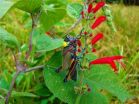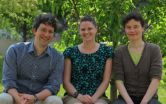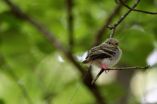(Press-News.org) Microscopes don't exactly lie, but their limitations affect the truths they can tell. For example, scanning electron microscopes (SEMs) simply can't see materials that don't conduct electricity very well, and their high energies can actually damage some types of samples.
In an effort to extract a little more truth from the world of nanomaterials and nanostructures, researchers at the National Institute of Standards and Technology (NIST) have built the first low-energy focused ion beam (FIB) microscope that uses a lithium ion source.*
The team's new approach opens up the possibility of creating a whole category of FIBs using any one of up to 20 different elements, greatly increasing the options for imaging, sculpting, or characterizing materials.
Although the new microscope's resolution isn't yet as good as a SEM or a helium ion microscope (HIM), it can image nonconductive materials and can more clearly visualize the chemical composition on the surface of a sample than the higher-energy SEMs and FIBs. And, by analyzing the energy with which the ions scatter, the researchers have shown that the microscope should be able to not only see that adjacent materials are chemically different, but also identify the elements that make them up.
Jabez McClelland and his colleagues at NIST applied Nobel Prize-winning laser cooling techniques to make the first low-energy FIB using lithium ions in 2011. Since then, they have been working to refine the technique to increase the beam's brightness and collimation, i.e., getting all the ions to move in the same direction to make it more useful for imaging applications.
The new instrument first cools a gas of neutral lithium atoms to a temperature of about 600 microkelvins, just a few millionths of a degree above absolute zero, using lasers and a magneto-optical trap (MOT) to hold the atoms. Another laser ionizes the atoms and then electric fields accelerate them, straightening out their flight and focusing the beam on a target.
The NIST FIB can produce lithium ion beams with energies in the range of 500 electron volts to 5,000 electron volts (compared to about30,000 electron volts for HIMs.) The NIST team can reduce the beam's energy even further, but repulsive interaction effects at the source limit how small they can focus the beam when the accelerating field is weaker.
As detailed in their paper, the team demonstrated how their microscope could help to solve a common problem in nanoimprint lithography, a process for stenciling patterns on silicon chips. This technique requires etching into the silicon through the spaces in the lithography stencil to transfer the pattern.
"Before manufacturers can etch the silicon, they have to make sure the spaces are free of chemical residue," says McClelland. "Commonly, they use a process called plasma etching to clean that residue off, but they have to be careful not to overdo it or they can damage the substrate and ruin the chip. Our FIB scope could check to see if the plasma has done its work without damaging the chip. A scanning electron microscope couldn't do this because it's difficult to see the thin residue, and the high-energy beam is likely to charge up and/or melt the stencil and make the problem worse."
The group has big plans for the microscope. One future project they're planning to do is trying to unravel exactly how lithium batteries work by injecting lithium ions into the materials and watching how they affect the behavior of the batteries. This and other applications will add to the capabilities of NIST's nanotechnology user facility, the Center for Nanoscale Science and Technology, where the work is being carried out.
A few former members of the group have started their own company to develop a low-energy cesium FIB for milling and sculpting features on the order of single nanometers, a huge leap in nanofabrication if successful.
"This new form of microscopy we've developed promises to provide a new tool for nanotechnology with good surface sensitivity, elemental contrast and high resolution," says McClelland. "The applications range from nanofabrication process control to nanomaterial development and imaging of biomaterials."
INFORMATION:
*K.A. Twedt, L. Chen and J.J. McClelland. Scanning ion microscopy with low energy lithium ions. Ultramicroscopy. Volume 142, July 2014, Pages 24.
This FIB doesn't lie: New NIST microscope sees what others can't
2014-05-08
ELSE PRESS RELEASES FROM THIS DATE:
Oregon researchers capture handoff of tracked object between brain hemispheres
2014-05-08
EUGENE, Ore. -- When tracking a moving object, the two halves of the human brain operate much like runners successfully passing a baton during a relay race, says a University of Oregon researcher.
In a study online ahead of print in Current Biology, electroencephalogram (EEG) measured brainwaves from healthy young adults revealed how information about an attended object -- one being watched closely -- moves from one brain hemisphere to the other.
Such handoffs are necessary because the human visual system is contralateral; objects on the left side of space are processed ...
New grasshopper species named after Grammy winner
2014-05-08
A newly discovered grasshopper by University of Central Florida scientists now bears the name of Grammy-award winning singer and activist Ana Lila Downs Sanchez.
The scientists named the new species discovered on the side of a mountain road near Oaxaca, Mexico, after the Mexican-American singer as a nod to her efforts to preserve indigenous culture and penchant for wearing colorful, local costumes as part of her performances.
"It was primarily Paolo's idea to name the grasshopper after the singer" said Derek Woller, one of the authors of the paper referring to colleague ...
Obesity drug failing patients due to lack of education about side-effects
2014-05-08
A new study, published today in the Journal of Health Psychology, found that patients who gained weight 18 months after taking Orlistat attributed their weight-loss failure either to the side effects which have prevented them from sticking to the medication or felt that the medication simply had not worked.
The team from the University of Surrey also found that participants described a series of barriers to weight loss including psychological and physical health issues, relationships and the make-up of their bodies. They also described a number of alternative methods ...
Urine test best detects alcohol use in liver transplant candidates, recipients
2014-05-08
Researchers from Italy confirm that urinary ethyl glucuronide (uEtG) accurately detects alcohol consumption in liver transplant candidates and recipients. The study published in Liver Transplantation, a journal of the American Association for the Study of Liver Diseases and the International Liver Transplantation Society, suggests that a combination of uEtG and the Alcohol Use Disorders Identification Test for alcohol consumption (AUDIT-c) are best in alerting doctors to alcohol consumption by patients undergoing evaluation for liver transplantation or who have received ...
Breakthrough made at Max F. Perutz Laboratories
2014-05-08
Researchers at the Max F. Perutz Laboratories (MFPL) of the University of Vienna and the Medical University of Vienna made a breakthrough for the Platynereis model system, as they describe the first method for generating specific and inheritable mutations in the species. The method, in combination with other tools, now places this marine bristle worm in an excellent position to advance research at the frontiers of neurobiology, chronobiology, evolutionary developmental biology and marine biology. The study and a review on Platynereis dumerilii genetic methods were chosen ...
Fungus may help stop invasive spread of tree-of-heaven
2014-05-08
A naturally occurring fungus might help curb the spread of an invasive tree species that is threatening forests in most of the United States, according to researchers.
Researchers tested the fungus -- Verticillium nonalfalfae -- by injecting it into tree-of-heaven, or Ailanthus, plots, according to Matthew Kasson, who recently received his doctorate in plant pathology and environmental microbiology from Penn State. The treatment completely eradicated the tree-of-heaven plants in those forests.
"It appears that this treatment is effective in Pennsylvania and could ...
New paper provides important insights into carcinoma-associated fibroblasts
2014-05-08
A new paper by a team of researchers led by Zachary T. Schafer, Coleman Assistant Professor of Cancer Biology in the Department of Biological Sciences at the University of Notre Dame, offers important new insights into the role carcinoma-associated fibroblasts (CAFs) play in tumor biology. A number of recent studies have revealed CAFs to be a major contributor to tumor progression through a variety of mechanisms. Despite this information, the precise role CAFs play in augmenting the growth of tumors is still poorly understood.
In their new paper, Schafer and his fellow ...
'Teenage' songbirds experience high mortality due to many causes, MU study finds
2014-05-08
Nearly one-third of songbird species across North America are experiencing long-term declines. Scientists have spent years researching potential causes for these population declines, focusing on the birds when they have just hatched as well as when they are adults. Now, researchers from the University of Missouri and the U.S. Department of Agriculture have found that songbirds are vulnerable to environmental dangers particularly when they are juveniles, shortly after they have left their parents' nests. Frank Thompson, a scientist with the USDA Forest Service and an associate ...
Hepatitis C virus: How viral proteins interact in human cells
2014-05-08
Viruses use human cells in order to multiply and spread. This process involves interactions with cellular host factors as well as virus-virus interactions. For example interactions among viral proteins are essential for the assembly of newly produced infectious virions.
Interaction network explains viral mechanisms and opens up possibilities for new treatments
Hepatitis C virus (HCV) forms a precursor protein, which is processed into ten viral proteins. Scientists at the Institute of Virology at the Helmholtz Zentrum have now discovered how these proteins interact with ...
Promising role for interleukin-10 in scarless wound healing
2014-05-08
New Rochelle, NY, May 8, 2014—The powerful anti-inflammatory compound interleukin-10 (IL-10) plays a crucial role in regenerative, scarless healing of fetal skin. Studies of IL-10 in postnatal skin wounds have demonstrated its promise as an anti-scarring therapeutic agent, as described in a Critical Review article published in Advances in Wound Care, a monthly peer-reviewed journal from Mary Ann Liebert, Inc., publishers and an Official Journal of the Wound Healing Society. The article is available free on the Advances in Wound Care website.
In "Regenerative Wound Healing: ...






